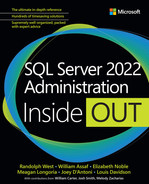Table of Contents
Part III: SQL Server management
Chapter 8 Maintain and monitor SQL Server
Chapter 9 Automate SQL Server administration
Chapter 10 Develop, deploy, and manage data recovery
Chapter 11 Implement high availability and disaster recovery
..................Content has been hidden....................
You can't read the all page of ebook, please click here login for view all page.
